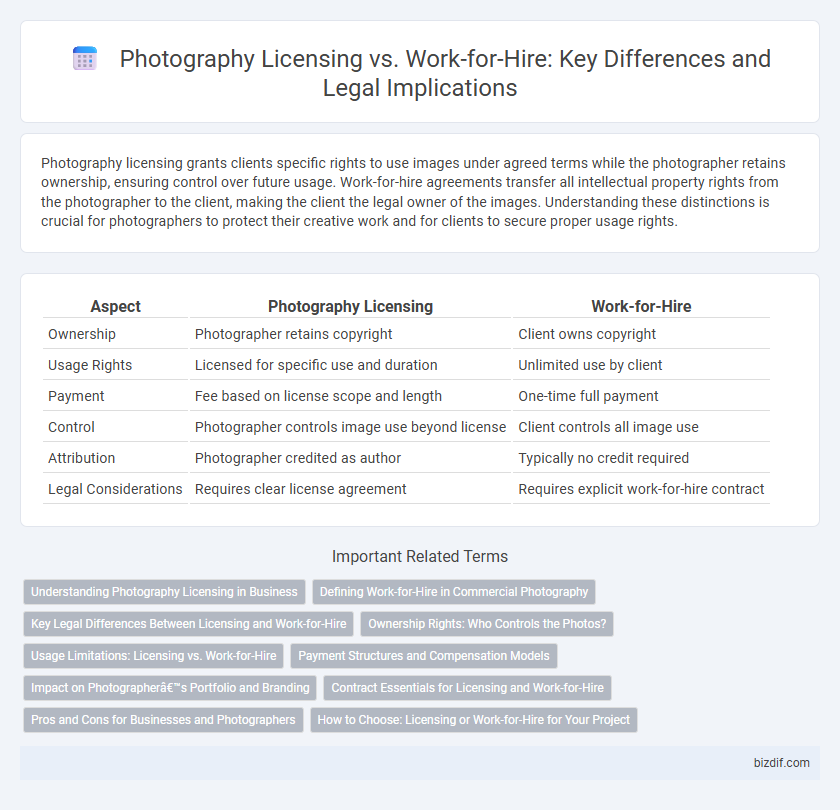Photography licensing grants clients specific rights to use images under agreed terms while the photographer retains ownership, ensuring control over future usage. Work-for-hire agreements transfer all intellectual property rights from the photographer to the client, making the client the legal owner of the images. Understanding these distinctions is crucial for photographers to protect their creative work and for clients to secure proper usage rights.
Table of Comparison
| Aspect | Photography Licensing | Work-for-Hire |
|---|---|---|
| Ownership | Photographer retains copyright | Client owns copyright |
| Usage Rights | Licensed for specific use and duration | Unlimited use by client |
| Payment | Fee based on license scope and length | One-time full payment |
| Control | Photographer controls image use beyond license | Client controls all image use |
| Attribution | Photographer credited as author | Typically no credit required |
| Legal Considerations | Requires clear license agreement | Requires explicit work-for-hire contract |
Understanding Photography Licensing in Business
Photography licensing defines the scope of usage rights a client receives, specifying how, where, and for how long images can be used without transferring ownership. Understanding licensing agreements is crucial for businesses to avoid legal disputes and ensure proper compensation for photographers based on usage type, duration, and distribution channels. Clear licensing terms protect photographers' intellectual property while providing clients with flexible options tailored to marketing, editorial, or commercial needs.
Defining Work-for-Hire in Commercial Photography
Work-for-hire in commercial photography means the client owns all rights to the images created, as the photographer is considered an employee or contractor producing work specifically commissioned under a contract. This legal arrangement transfers copyright ownership directly to the client upon creation, eliminating the need for licensing agreements or rights transfers. Understanding work-for-hire is crucial for photographers negotiating contracts to ensure clear ownership and usage of commercial photographs.
Key Legal Differences Between Licensing and Work-for-Hire
Photography licensing grants specific usage rights of images to clients while the photographer retains copyright ownership, allowing potential reuse or resale. Work-for-hire agreements transfer full copyright ownership to the client, giving them complete control over the photographs without restrictions. Understanding these legal distinctions is crucial for photographers to protect their intellectual property and define clear usage terms.
Ownership Rights: Who Controls the Photos?
Photography licensing grants specified usage rights to clients while the photographer retains ownership of the images, allowing control over reproduction and distribution. Work-for-hire agreements transfer full copyright ownership to the client, who then holds exclusive control over how the photos are used. Understanding the distinction in ownership rights is crucial for photographers to protect their creative assets and for clients to clarify usage permissions.
Usage Limitations: Licensing vs. Work-for-Hire
Photography licensing grants clients specific usage rights while the photographer retains ownership, enabling controlled use such as limited print runs or digital display. Work-for-hire transfers full ownership to the client, removing usage restrictions but also the photographer's control over future applications. Understanding these differences is crucial for managing intellectual property and maximizing revenue streams in professional photography.
Payment Structures and Compensation Models
Photography licensing typically involves negotiated usage rights with ongoing royalties based on factors such as duration, territory, and media, offering photographers potential residual income. Work-for-hire contracts provide a one-time payment with all rights transferred to the client, eliminating future royalty claims regardless of how extensively the images are used. Understanding these compensation models is crucial for photographers to maximize revenue and control over their intellectual property.
Impact on Photographer’s Portfolio and Branding
Photography licensing allows photographers to retain ownership of their work, enabling reuse in their portfolios and consistent branding that reflects their style and expertise. Work-for-hire agreements transfer ownership rights to the client, limiting the photographer's ability to showcase the images publicly and potentially restricting portfolio growth. This distinction significantly affects long-term brand development and professional visibility within the photography industry.
Contract Essentials for Licensing and Work-for-Hire
Photography licensing requires clear specifications about usage rights, duration, territory, and media to protect both photographer and client interests. Work-for-hire contracts must explicitly state the transfer of all copyright ownership from photographer to client upon project completion. Precise definitions of deliverables and payment terms prevent legal disputes and ensure mutual understanding in both licensing and work-for-hire agreements.
Pros and Cons for Businesses and Photographers
Photography licensing offers businesses flexible usage rights while allowing photographers to retain ownership and earn ongoing royalties; however, license terms can be complex and may limit how images are used. Work-for-hire agreements grant businesses full copyright ownership, simplifying image use and exclusivity but often result in one-time payments with no future royalties for photographers. Choosing between these models depends on balancing control, cost, and long-term value for both businesses and photographers.
How to Choose: Licensing or Work-for-Hire for Your Project
Choosing between photography licensing and work-for-hire agreements depends on the intended use and control of the images. Licensing grants clients specific usage rights while photographers retain ownership, ideal for ongoing royalties and usage flexibility. Work-for-hire transfers full ownership to the client, suitable for exclusive projects requiring complete control and reproduction rights.
Photography Licensing vs Work-for-Hire Infographic

 bizdif.com
bizdif.com